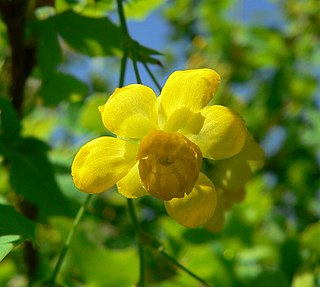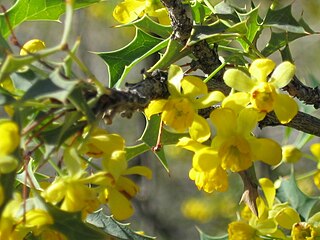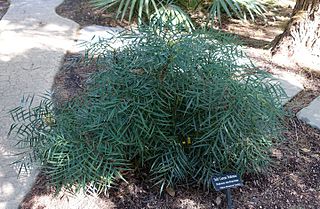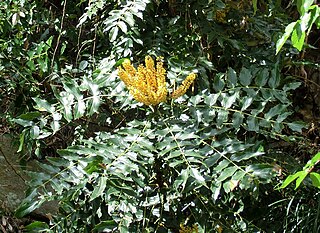
Berberis aquifolium, the Oregon grape or holly-leaved barberry, is a species of flowering plant in the family Berberidaceae, native to western North America. It is an evergreen shrub growing 1–3 meters tall and 1.5 m (5 ft) wide, with pinnate leaves consisting of spiny leaflets, and dense clusters of yellow flowers in early spring, followed by dark bluish-black berries.

Mahonia is a formerly accepted genus of approximately 70 species of shrubs or, rarely, small trees with evergreen leaves in the family Berberidaceae, native to eastern Asia, the Himalaya, North America, and Central America. They are closely related to the genus Berberis and as of 2023 the majority of botanical sources list it as a synonym for Berberis.

Berberis, commonly known as barberry, is a large genus of deciduous and evergreen shrubs from 1–5 m (3.3–16.4 ft) tall, found throughout temperate and subtropical regions of the world. Species diversity is greatest in South America and Asia; Europe, Africa and North America have native species as well. The best-known Berberis species is the European barberry, Berberis vulgaris, which is common in Europe, North Africa, the Middle East, and central Asia, and has been widely introduced in North America. Many of the species have spines on the shoots and all along the margins of the leaves.

Berberis pinnata is a species of shrub in the barberry family. Common names include California barberry, wavyleaf barberry, and shinyleaf mahonia. It is similar to the Oregon-grape, and is sometimes called the California Oregon-grape.

Berberis repens commonly known as creeping mahonia, creeping grape holly, or creeping barberry, is a species of Berberis native to most of the western United States and two western provinces of Canada. It is low growing shrub that spreads by underground stems. As a species it is well adapted to fire and is a very common understory plant in western forests. An evergreen species, it provides food to deer and elk in winter and can make up a significant part of their diet. The berries are eaten by birds and small mammals, aiding it in spreading to recently disturbed areas. It has found use as a xeric ornamental plant and has escaped from cultivation in areas beyond its native range.

Berberis trifoliolata is a species of flowering plant in the family Berberidaceae, in southwestern North America. Common names include agarita, agrito, algerita, currant-of-Texas, wild currant, and chaparral berry. The name Agarita comes from the Spanish verb agarrar, which means "to grab". The ending "-ita" is often added to little things, so agarita means "grabs a little". This was probably said because the bush is a bit scratchy but does not have significant spines. Typical characteristics are grey-green to blue-grey leaves, yellow flowers in February to April and the red berries appearing in May. The most important harvest organ are the berries, though the roots and seeds can also be used.

Berberis oiwakensis is a species of plant in the barberry family, Berberidaceae. It is native to Taiwan, China and Myanmar, where it occurs at elevations of 600 to 3800 m. It has recently been found naturalized in South Africa.

Berberis fremontii is a species of barberry known by the common name Frémont's mahonia.

Berberis japonica is a species of flowering plant in the family Berberidaceae, native to Taiwan. Despite the name, it is not native to Japan, though it has been known in cultivation there for centuries. The wild origins of this species have long puzzled botanists, but wild plants in Taiwan, previously known under the name Mahonia tikushiensis, appear most similar to the cultivated forms of B. japonica.

Berberis harrisoniana is a rare species of flowering plant in the barberry family, Berberidaceae. It is known by the common names Kofa barberry, Kofa Mountain barberry, Harrison's barberry, and red barberry.

Berberis haematocarpa, Woot. with the common names red barberry, red Mexican barbery, Colorado barberry and Mexican barberry, is a species in the Barberry family in southwestern North America. It is also sometimes called algerita, but that name is more often applied to its relative, Mahonia trifoliolata.

Berberis bealei, also known as leatherleaf mahonia, Beale's barberry, is a species of evergreen shrub native to mainland China. The species has been regarded as the same species as Berberis japonica, native to Taiwan, but the two differ consistently in certain floral and leaf characters. Both species are widely cultivated in many countries as ornamentals. Berberis bealei has reportedly escaped cultivation and become established in the wild in scattered places in the south-eastern United States from Arkansas to Florida to Delaware.

Berberis gracilis is a plant species native to the Mexico, widely distributed from Tamaulipas to Oaxaca.

Berberis eurybracteata is a species of shrub in the Berberidaceae described as a species in 1901. It is endemic to China.

Berberis gracilipes is a shrub in the family Berberidaceae, first described in 1887. It is endemic to China, native to the Sichuan and Yunnan Provinces.

Berberis napaulensis Nepali: जमाने मान्द्रो is a shrub in the family Berberidaceae described as a species in 1821. It is native to China and the Himalayas. This species is used medicinally throughout the Sikkim Eastern Himalayas.
Berberis polyodonta is a shrub in the Berberidaceae described as a species in 1901. It is native to Assam, Myanmar, and southwestern China.
Berberis ehrenbergii is a shrub in the Berberidaceae described as a species in 1847. It is native to the States of Chiapas, Tamaulipas, and Veracruz in southern Mexico.
Berberis incerta is a shrub described as a species in 1901. It is endemic to eastern Mexico, known from the States of Hidalgo and Veracruz.
Berberis eutriphylla is a species of shrub in the Berberidaceae described as a species in 1901. It is endemic to northern and central Mexico, from Coahuila to Mexico State.
















